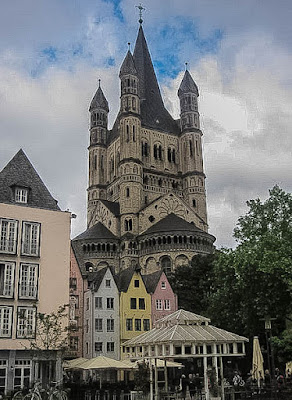The history of Great St. Martin Church in Cologne is complicated.
 |
| Great St. Martin Church in Cologne, Germany. |
The site was originally an island in the Rhine and had a building on it dating from the 1st century CE. No similar structures from this time period north of the Alps have been found and so no one knows what the use of the building was. In the 2nd century CE additional buildings were built and they appear to have been used as a storage for market goods shipped on the Rhine. Then it appears that a church was built on the site by Bruno the Great between 953 and 965. In 989 the church was turned into a monastery for Benedictine monks from Ireland. The local archbishop, Pilgrim of Cologne, did not want the presence of the Irish monks and he pushed for their removal. The last Irish abbot, Arnold of St. Martin, died in 1103. In 1150 a fire burned most of Cologne and the entire church was probably destroyed. The Archbishop of Cologne, Philipp I. von Heinsberg, directed the building of a new church and a form of what the current church looks like was built: three round apses meeting in the shape of a cross. Bits and pieces were added to it over the years until it was completed in the 13th century. A fire in 1378 destroyed the roofs of the four towers. A storm in 1434 blew down three of the four gables on the towers.
 |
| It looks massive from well below ground level. |
During the French Revolution, in October 1794, Cologne was captured by the revolutionary army and occupied for 20 years and an anti-clerical movement began. The archbishopric in Cologne ended in 1801 and the cloister at Great St. Martin was disbanded in 1802. In 1808 the abbey building was a living quarters for French veterans and it was later demolished for use as building materials in other parts of the city. In 1843 the city of Cologne decided to finance the restoration of the church. It was completed in about 1875.
During World War II Great St. Martin was virtually destroyed by bombing. After the war significant thought was put into whether to rebuild Great St. Martin or to leave it as a war memorial. It was decided to restore it and restoration efforts began in 1948. It was completed in 1985 and opened to worshipers, after an absence of 40 years.
 |
| Glimpses of the church loom above narrow alleys. |
As of 2009, Great St. Martin is being used by a branch of the Monastic Fraternities of Jerusalem which promotes the spirit of the monastic desert in the heart of cities.
When we visited a mass was going on and we did not get to visit parts of the church. Parts that we visited are extremely barren. It has the sense of an abandoned warehouse. I suspect that may be part of the program of the monastery now with its emphasis of a desert in the heart of a city.
The outside of the structure is very impressive. It has one main spire surrounded by four smaller ones. It reminds me of an Apollo moon launch with booster rockets attached to the sides.
 |
| It dwarfs the buildings around it. |
The most interesting part of the church is a section of the stained glass windows that are haunting. I may be interpreting them completely wrong, but they are very modern, very stark and seem anti-war. They seem skeletal and bloody, perhaps a commentary on Germany's involvement in the war?
 |
| This is a section of the window above. |
 |
| Another section of the window two above. |
 |
| The darkened eyes convey an image of sadness. |
 |
| More dark eyes. |
 |
This is a segment of the window above. It appears a large knife is in one hand and on the other side is a severed arm.
|
 |
| This is also a segment of the window. |
I also ran across several German versions of the Stations of the Cross with the participants in medieval German garb.
Finally, there were several mosaic floor decorations that were kind of fun.









It is impressive to me that the people would keep rebuilding this church. Those windows seem especially appropriate for a church that was destroyed so many times.
ReplyDelete